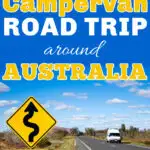So you want to road trip around Australia in a camper van?
When we set off on our first road trip around Australia there were so many things that we didn’t know we didn’t know. And there were also a lot of things that we knew we didn’t know, but didn’t know where to get the answers!
So this post is full of the basic information that you just don’t know when you’re either from another country, or haven’t campervanned or caravanned in Australia.
Whether you’re a backpacker from another country wanting to buy a cheap van and see all of Australia with a couple of friends, a young person converting their own van, or a retired couple in a new van setting off to enjoy their golden years, this will help you in your planning.
It’s a massive post though, so you’ll probably want to use the Table of Contents below to get the answers to your burning questions.
- So you want to road trip around Australia in a camper van?
- 1. The mistakes we made (that maybe you can avoid)
- 2. Renting a campervan in Australia
- 3. Buying a campervan in Australia
- 3. How the camping works in Australia
- 4. How to set up your van for self-sufficient camping
- 5. Emergency Preparedness
- 6. Keeping in touch
- 7. How to plan your route around Australia
- 8. How to pack for a road trip around Australia
- 9. Driving around Australia in a camper van
- 10. How much does it cost to road trip Australia?
- 11. How to fund your road trip around Australia
Let’s get stuck in!
1. The mistakes we made (that maybe you can avoid)
One of the reasons I wanted to write all this down is that there were a couple of key things that we would have done differently if we’d been more prepared.
Picking the right camper for us
I think it’s pretty common, where your first purchase of a home-on-wheels is NOT the right one.
It’s not until you’ve travelled in it, realised what type of travelling you like to do, the comforts that you don’t want to give up, and those features that you just don’t care about.
You have to take it around with you for hundreds of kilometres, set it up, pack it down, be stuck in it in the rain, sleep in it in the heat, cook in it, eat in it and clean it.
Then maybe, you’ll have an idea if it’s the right type of vehicle for you.
For us, we got it quite wrong.
We started with a camper trailer… because it was cheap.

Then we moved on to a vintage caravan. Much, MUCH better, but still not right for us.
Our next move will be into a campervan. And it must have a toilet!
Funding our trip
Our first trip was meant to be 9 months, maybe 12 months if we were really careful.
Six months (well, it was actually more like 5 months) and our bank balance was already running very low!
We didn’t really have a plan for what we’d do if we weren’t able to make our online efforts profitable (and at the time, they weren’t) so we just had to stop and get jobs.
There’s nothing wrong with that, and a lot of people choose to do it that way.
We just hadn’t really figured out how we were going to make money. I’ve got a whole section below on ‘How to fund your trip’, but in hindsight, it would have been better if we’d had that sorted before we left.
2. Renting a campervan in Australia
To Rent or Buy?
You’ve got two options for a van to road trip around Australia, you can rent a campervan, or buy one. There are two main factors which will determine the option that will suit you best.
- How long is your trip? If it’s only a couple of weeks, then it certainly doesn’t make sense to go through all the hassle of buying a vehicle. If you’re planning on staying for a couple of months? Well then it starts to make more sense financially, if you buy a vehicle.
- The other factor to consider is whether or not you’re planning to go off-road. If it’s a 4WD drive adventure that you want, purchasing your own 4WD campervan may be the best option.

There are certainly some great places around Australia that can only be reached with a 4×4 vehicle, BUT there’s also sooo much to do and see with just a 2WD.
But do your research first, if the places you want to go to require 4WD, then that’s what you’ll need.
If your Australian road trip is a couple of months or less, then renting a vehicle will probably be your best option.
You can use the search box below to book a campervan in Australia, or just to see how much it will cost.
Just a couple of things to note:
Insurance – particularly for off-road
If you’re going to go off the sealed highway (at all!) then make sure you get the right vehicle and insurance package to go with it.
It will cost you more, but if anything happens while you’re on the unsealed road you could be up for a hefty insurance excess … and that’s if you’re lucky enough to still be covered.
One-way rentals
You would need to fly into a main city and pick up your vehicle there. Main cities include: Sydney, Melbourne, Perth, Brisbane, Adelaide, Cairns, Darwin or Hobart.
But if you’re planning on doing a one-way rental, for example flying in to Perth, driving a rental vehicle across to Sydney and leaving it there, make sure to check out the costs. One-way rentals can be very expensive here in Australia.
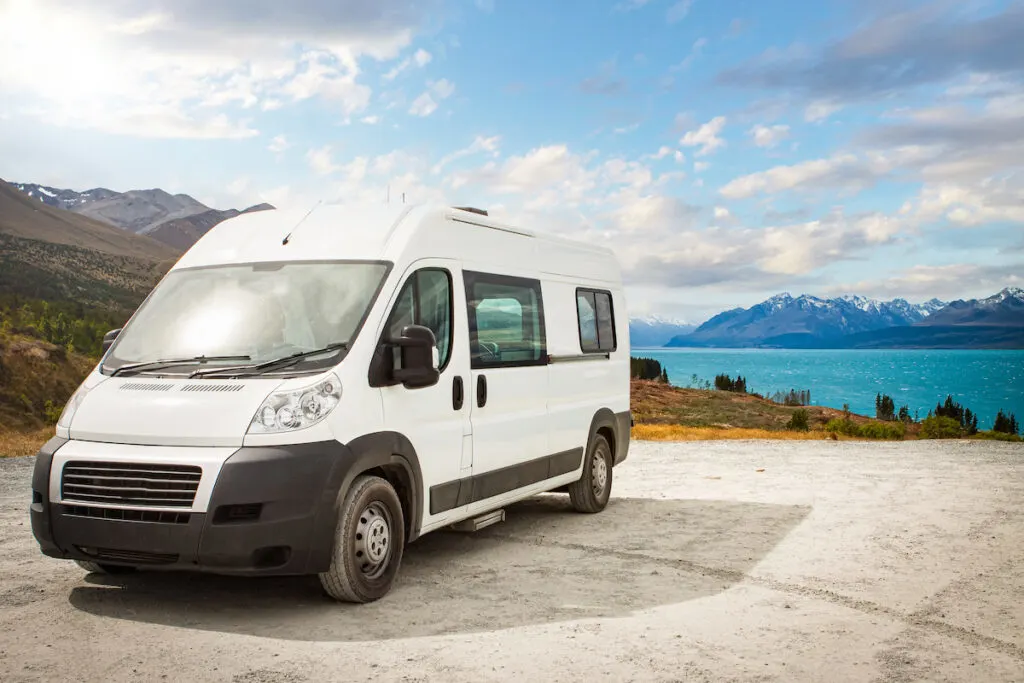
3. Buying a campervan in Australia
If you’re going to be in Australia for more than a couple of months, then buying a (used) campervan probably makes the most sense for you.
Dealership or Private Sale
In Australia, there are two main ways you can purchase a campervan. By buying from a dealership, or from a private party.
When you buy from a dealership it’s less hassle than buying privately. A dealership:
- Will have inspected the vehicle and made repairs if necessary
- Gives you more legal protection because they can only operate within strict laws
- Will handle all the paperwork such as transfer of ownership
- Must provide a history check of the vehicle
- Can offer extras such as warranties and road side assistance
Generally, the biggest benefit to buying private, rather than from a dealer, is that the seller may have more room to negotiate on their price. That can mean a saving of thousands of dollars, but offers less security for the buyer.
Buying an ex-rental
When the campervan hire companies update their rental stock with newer vans, they will sell their old stock of vans. Here’s where you can get more info on buying an ex-rental campervan.

While these vans will have a tonne of kilometres on them, you’ll know that they’ve been well serviced and regularly, and that they’re already kitted out with everything you need.
And some of these companies offer a guaranteed buy back where they will buy the vehicle back from you at an agreed price after your trip. They’ll buy it back at approx. 30-50% of the original purchase price, based on when you bring it back (it needs to be within 12 months). You just have to have it regularly serviced.
I notice the guaranteed buy back scheme seems to apply to the older, smaller & cheaper campervans; those types of vehicles that would be ideal for young backpackers.
Petrol or Diesel
You can get both petrol and diesel pretty much everywhere around Australia.
Personally, I’ve found that in more metropolitan areas there are fewer diesel bowsers at the gas station. If there are 10 bowsers, then maybe 2 of them will be diesel. (But then, there are less diesel vehicles in metro areas too.)
The more rural you go, the more often diesel is found. I’ve read that in some of the really remote places, you can only buy diesel, and if you happen to get stranded with no fuel, a passing motorist, local road workers or nearby farmhouse, is more likely to have diesel than petrol.
Research before you get here
Once you’re figured out which city you’ll be starting from, start looking for the type of campervan that you would like to buy, and follow the marketplaces websites.
The reason why I recommend this, is that it gives you an idea of the prices and which types of vehicles sell faster than others. This can help you to get an idea of prices, the condition you can expect a car to be in (at a particular price range) and the availability of different types of vehicles.
You’ll also notice how quickly campervans are getting sold.
Marketplaces for campervans:
- Gumtree.com.au – Gumtree is probably the equivalent of eBay or Craigslist and both dealers and private sellers advertise on here.
- CaravanCampingSales.com.au
- Facebook Marketplace – just be mindful of scams
Checks that need to be done prior to purchase:
If you’re doing a private purchase, then you must do a check of who is the legal owner and if there is any finance on the car. This is easily done online at: https://checkrego.com.au/
Pre-Purchase Inspection
Regardless of whether you’re buying from a dealership or a private party, I would still recommend getting a pre-purchase inspection of the vehicle. If you’re confident to do that yourself, that’s cool, but if you’re as clueless as me about all things mechanical, you’ll need to book a pre-purchase inspection with a local mechanic or an organisation like the NRMA.
The pre-purchase inspections, while not fool-proof, give a bit of peace of mind for those of us mechanically challenged.
Here are some checklists to help you on your initial inspection.
Camplify.com.au – Ultimate Guide to Buying a Used Campervan
RollingSolo.com.au – Killer Checklist for Buying a Motorhome or Caravan
Ownership Costs
Of course, there are always costs associated with owning a vehicle. For any international visitors, here’s what you’ll need to consider for Australia.
Car registration
Vehicle registration is different in each of the eight states of Australia. But here’s the general information:
- Registration lasts for a year
- You may need to have your vehicle inspected (at a registered inspection centre, such as a mechanic) for road-worthiness
- If the registration runs out while you’re on your trip, you may need to return to the state that the vehicle is registered in, to re-register.
- You are required to purchase Compulsory Third Party (CTP) insurance when you register your vehicle.
The rules and costs are different for each state, so if you already know where you’re going to buy your vehicle here are the links to each states vehicle registration information:
Insurance
Australia is not like the USA where you need massive insurance in order to just walk down the street, but you will want to have vehicle insurance.
In Australia we have Compulsory Third Party (CTP) insurance which is paid when your vehicle is registered (you can’t register without it). CTP is not comprehensive insurance, it only provides the driver cover for any legal liability for injury or death as a result of an accident for which the insured is responsible.
You can easily purchase comprehensive insurance online. When we bought our car, I organized our insurance over the internet (on my phone) while Ben went through the sale process with the seller. By the time we drove off, we were fully covered.
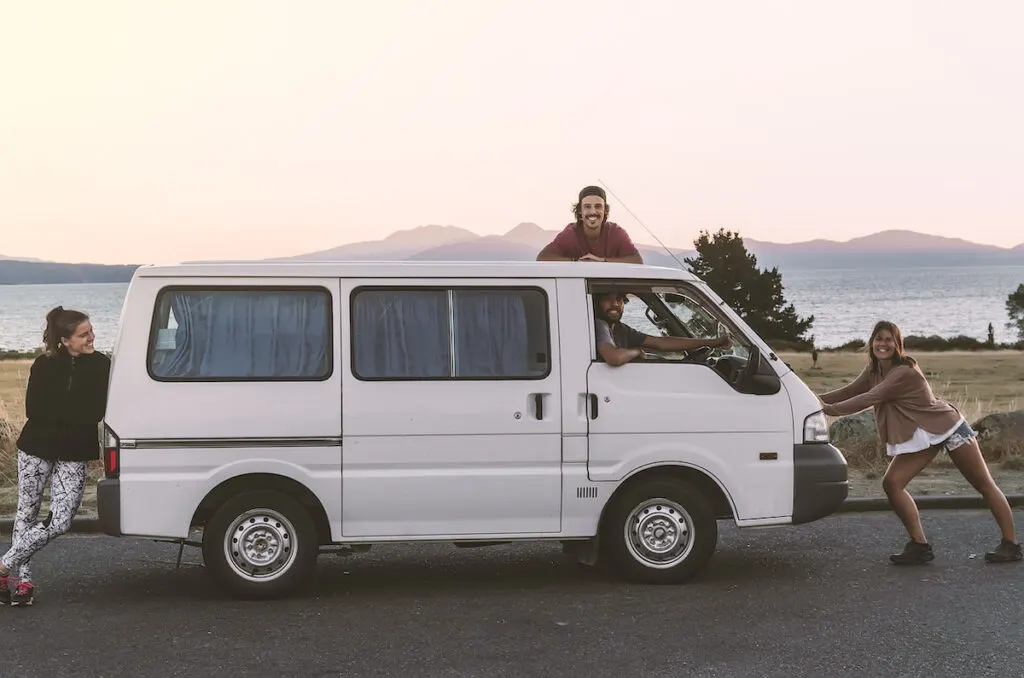
Roadside Assistance
This isn’t a pre-requisite of owning a vehicle, but it’s a very, very high on the list of ‘should haves’.
Unless you’re a mechanic yourself, travelling with all your tools… and spare parts, then you should have road side assistance. ESPECIALLY if you’re travelling to remote areas. You’ve got to remember that in some parts of Australia it could be 300kms to the nearest town, and by town I mean a pub, general store and a gas station. Getting a tow truck could cost you thousands and if your vehicle is broken down, you’ve got no way to tow your home. It gets very complicated, very quickly. Just get roadside assistance, okay?
The various RAC is each state:
RAC (WA)
RACV (VIC)
RACQ (QLD)
Once you’ve got your vehicle sorted, you’ll be looking for somewhere to park each night…
Need help finding your perfect campervan? Sign up for our newsletter and grab our free spreadsheet!
The spreadsheet contains 140 campervans and vans with dimensions and features of each van so you can filter for the things you want. It took ages to put it together, and I did it with the hope that it would be as helpful to others as it was to me. And it’s updated regularly.
When you sign up for the spreadsheet you’ll also get our weekly newsletter where we’ll send you info on converting a van, new models, upcoming meetups / shows and #vanlife tips. Unsubscribe at any time.
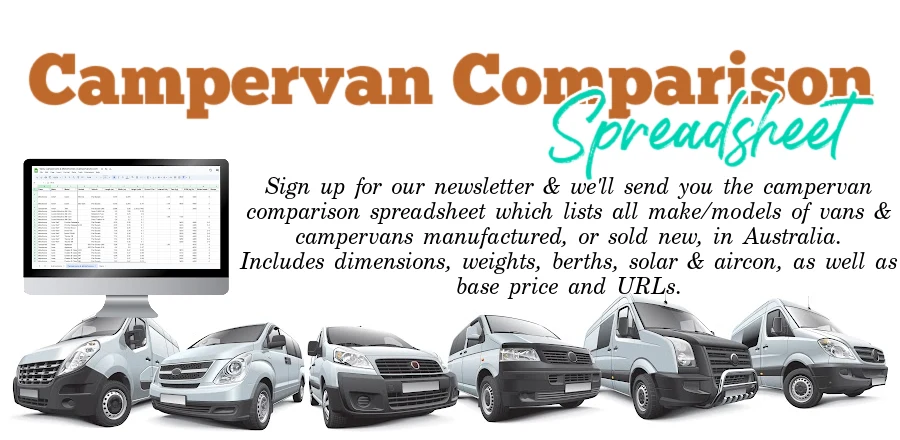
3. How the camping works in Australia
I want to talk about camping in Australia, because the type of camping you want to do will help determine the type of set-up you need and any of the accessories you’ll likely want.
Caravan Parks
Caravan parks can be found all over Australia. In every city and town and sometimes even in the very smallest of towns that, if you blink, you’ll miss it.
All caravan parks will have the following facilities:
- Powered sites – where you can plug into 240V power and water, and drain your grey water.
- A facilities block – with toilets, showers & laundry room
- A kitchen – with basic cooking (sink, stove, fridge, bench space) but many have extra things such as toaster, oven, blender, pots and pans, crockery and cutlery.
- Dumping – so you can empty your toilet cassette or black tank.
Caravan parks can vary widely, from a basic campsite with not much appeal (or grass), to resort-like complexes with multiple pools, children’s play areas, cafes, games rooms and mini-golf.

Private Camping Sites
With the popularity of apps/websites like WikiCamps and Hipcamp it’s been much easier for people to set up campsites on their private property. Since campers will use the app to find their next campsite, the private campsite owners don’t need to spend a fortune on traditional advertising. They just list their campsite on WikiCamps/Hipcampand that’s it.
This could include farms, lifestyle blocks, the local pub with a big garden out the back or some other business with space out the back.
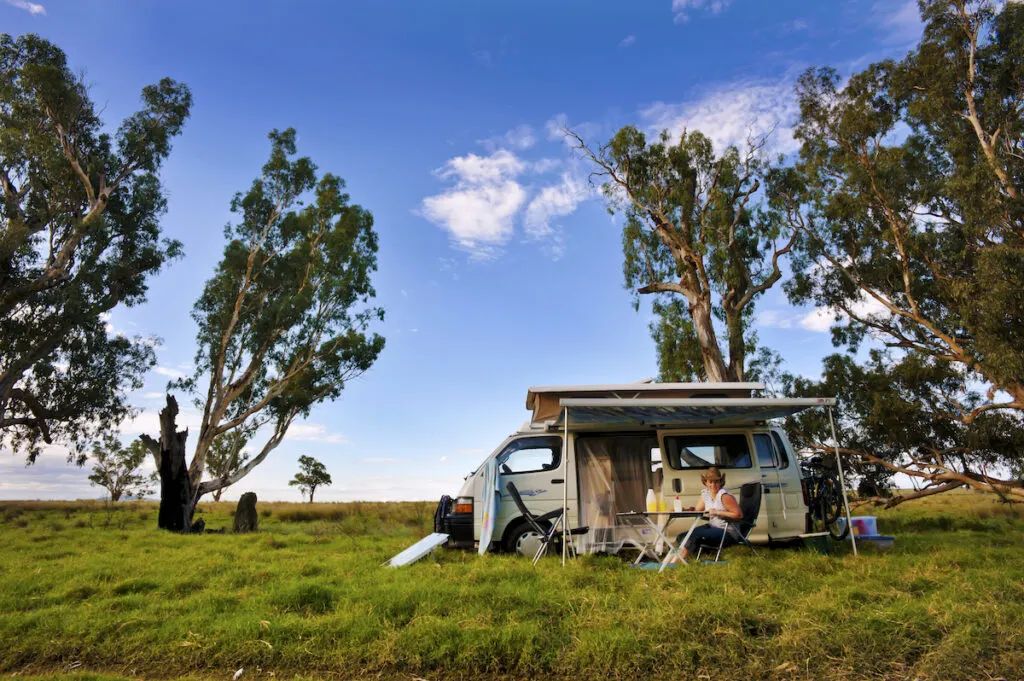
It may just be grassy spot down by the river with no facilities, or a powered site with water and access to a bathroom block.
Prices are also variable, it can be quite pricey if you’re in a popular tourist area, or it may be ‘free’ but with the expectation that you will buy a drink and/or a meal in the pub.
National Parks
There are over 500 National Parks in Australia and they provide some of the best outdoor experiences. Each of the National Parks is managed by the state government, so they’re all different.
You will find that there is a huge array of camping options, from free camping with no facilities, to fully managed campsites with power, water, dump points and a kitchen.
Some of the National Parks require that you pay a fee to enter the park, and then you pay camping fees on top of that. But they’re all different, so search the website of the National Park for each state. These links should get you started:
- NSW – NSW National Parks and Wildlife Service
- VIC – Parks Victoria
- QLD – QLD Parks and Forests
- SA – National Parks and Wildlife Service South Australia
- WA – Parks and Wildlife Service Western Australia
- ACT – Parks ACT
- NT – Parks and Reserves NT
- TAS – Tasmania Parks & Wildlife Service
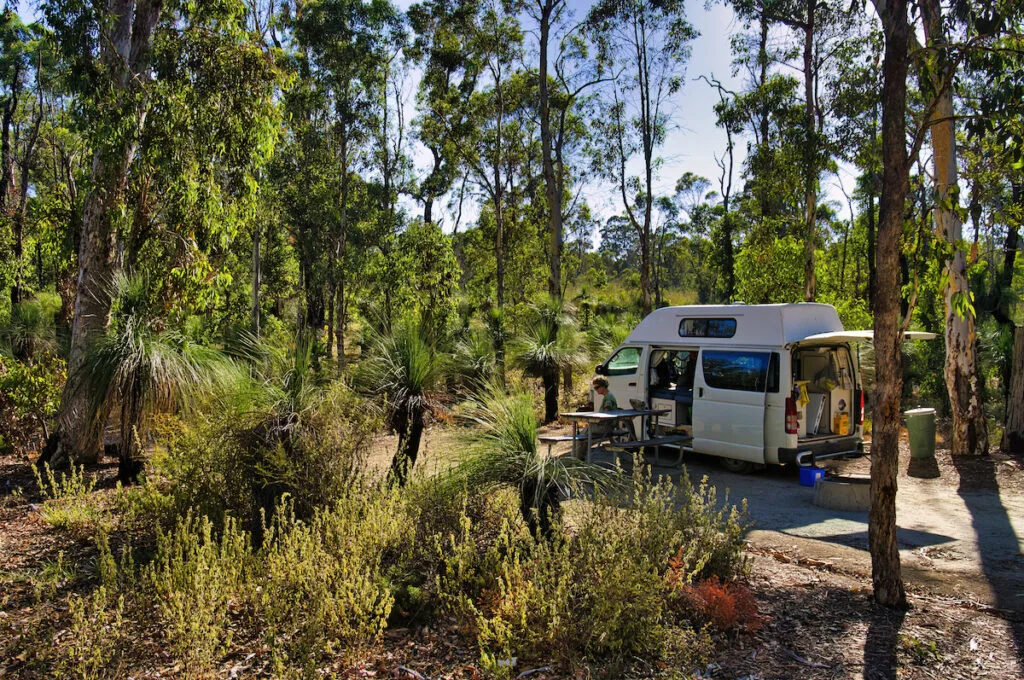
Free or Low-Cost Camps
First lesson… you will not find free camps in very touristy areas.
For example, if you’re travelling anywhere along the east coast, don’t expect to find any free camps on the beach. For free camps, you will need to head inland and further away from the main touristy areas and then you’ll find HEAPS of free or low cost camping options.
The one caveat I have to not being able to find free camping along the east coast, is rest stops. There are quite a lot of roadside rest stops where you’re able to stop for the night. But they’re not exactly in scenic areas, can be noisy since they’re right beside the highway and may or may not have facilities. Most will have at least a long drop toilet, but that’s about it.
A lot of them are designated truck parking areas, these are rest areas for truck drivers only, so DO NOT park in them. (They’re sign-posted)
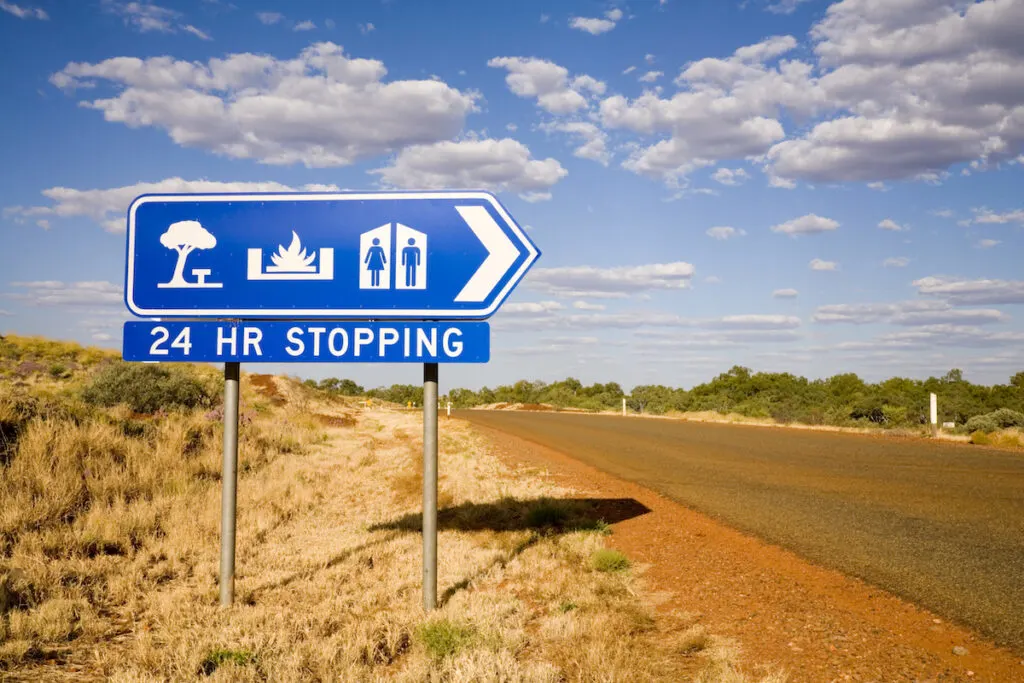
How to find campsites
Here are the two most common ways to find campsites in Australia:
WikiCamps
This app is a crowd-sourced database of all the campground and caravan parks across Australia. It shows the details of the campsite, the facilities available, the cost, as well as other information such as whether they allow dogs, local sites to see and the proximity to other amenities. The value of the app lies in the ability to filter the results and the comments, ratings, photos and updated costs of fellow campers.
The app also shows places of interest, dump points, day use areas and even has a map feature to direct you straight to the campsite.
At just $9.99 Wikicamps is well worth it. https://www.wikicamps.com.au/
Camps Australia
Camps Australia is also now an app (they used to be only a physical book) which is free, but you can upgrade for more features.
I think that the main difference with the Camps Australia list of campsites, is that they’re all verified sites. https://www.campsaustraliawide.com/app/
4. How to set up your van for self-sufficient camping
Okay, so now that you know the different types of camping that you can do in Australia, hopefully you’ve got an idea of the type that you and your companions will want to do.
If you’re going to be staying in caravan parks for the duration of your trip, then you will be fine with a more basic set-up; you can use the caravan parks’ toilet, shower, kitchen and laundry. You can charge up your electronic devices each night using the supplied power, you can get fresh drinking water and dump your toilet (if you have one).
But if you’re planning to do free or low-cost camping then you’ll need to be self-sufficient. And that means having access to the following things:
- Water supply
- Toilet
- Power
- Grey water disposal
Water
When you’re free camping you probably won’t have access to drinking water, so you need to take enough for you and your travelling companions, for the number of days you plan to stay.
Your campervan is likely to have a water tank already, but consider how big the tank is, and all the things you’ll be using that water for such as: drinking, cooking, washing (dishes and people) and the toilet.
In order to extend your stay you’ll need to think about ways to conserve water, carry more water or have a way of re-filling your water. This may include things such as:
- Taking navy showers, or no showers, especially if there is a river or lake where everyone can go for a swim. (No soaps in the waterways though!)
- Taking extra water such as water jerry cans, water bladder or even just extra plastic bottles of drinking water.
You’ve got to remember that in some areas of Australia (i.e. the whole middle of Australia) water is scarce and you need to be mindful of where you’re going and if there’ll be water.
It’s no problem in built up areas, but you’ll need to think about this fact when travelling in remote areas.
Toilet
When we first set out on our road trip around Australia, I had thought that an on-board toilet wasn’t such a high priority. I figured that if we’re free camping with no toilet facilities, then I’d just go in the bush. But not all free camps are out in the bush. Some are beside the highway, or in an open field, or jam-packed with other free campers.
This is where it really comes in handy to have your own toilet on-board.
There are a couple of different types of toilet, that I think it would be handy to know about.
Cassette Toilet
This is the most common campervan toilet that you will find in Australia. It’s not too dissimilar to a regular toilet, you open the flap at the bottom of the bowl, you do your business and when you flush it empties into a small holding tank/cassette, and then you close the flap.
Emptying the cassette involves taking the cassette out and dumping it into a dump station or in a toilet.
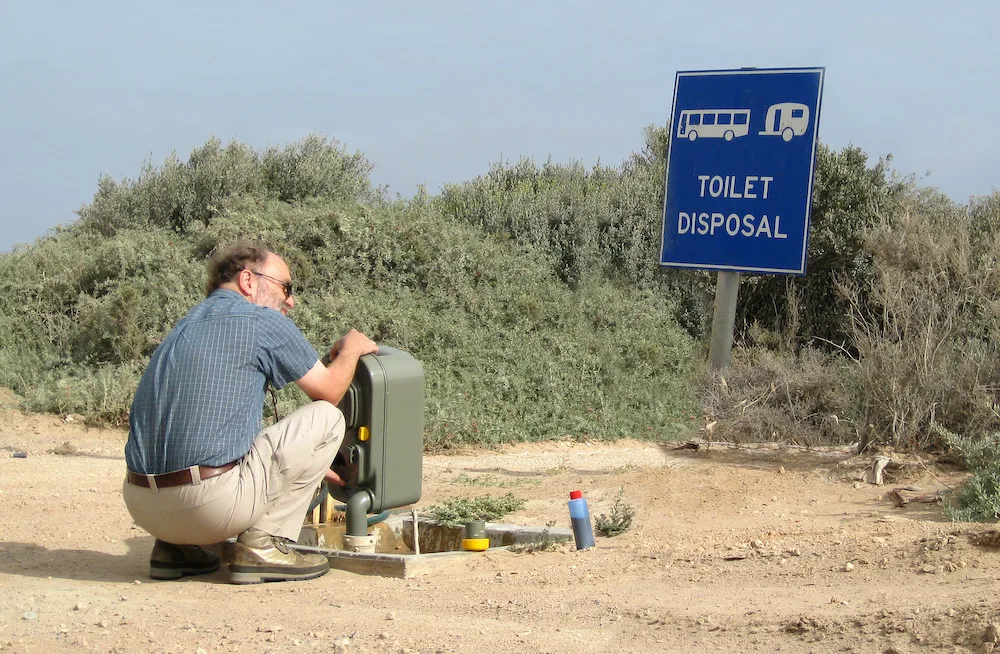
Portable/Chemical Toilet
The porta potty or chemical toilet is a self-contained unit you can use anywhere. It works on the same principle as the cassette toilet above, but the porta potty comes in two parts with the holding tank or cassette part right under the toilet seat part. You can easily separate the bottom half of the toilet from the top half so that you can dispose of the contents.
The porta potty can be easily moved around (just pick it up, it’s not attached to anything and doesn’t have any hoses etc) which makes it a great emergency loo.
Store it anywhere in your van and just bring it out when it’s needed.
Going Bush
In less populated areas of Australia, it’s acceptable to go to the toilet out in nature. However, there is a bit of etiquette involved in this.
Here’s some basic tips for going bush toilet in Australia:
- Be discreet. No one wants to see you flashing your bits around and definitely no one needs to see you defecating.
- Number two’s require you to dig a hole. Don’t just break ground , but dig a decent depth hole that isn’t just going to have the dirt blown away.
- Toilet paper – now this is really important. We have a little bit of an ongoing problem with toilet paper being disposed of incorrectly and creating a despicable scene at some of our most beautiful spots.
DO NOT leave your toilet paper behind. Don’t bury it, because it will get dug up by some curious critter.
You have two options:
- either put a match to your toilet paper and burn it (although not in the middle of a dry field or during a fire ban!) OR
- just put it in the rubbish. Take a little rubbish bag with you and put your loo paper straight in there after use.
It’s so easy to do, yet some people seem to think they’re exempt from this problem and refuse to dispose of their toilet paper properly. Once you see toilet paper strewn around, you’ll know exactly what I’m talking about, and you’ll be as annoyed (and flabbergasted) by it as I am.
Power
Central to your power solution is your batteries. You’ll use them to keep power hungry things going, like:
- Fridge
- Lights
- Electronic devices such as laptop, phone, camera equipment
- Microwave, coffee maker, TV
But you’ll need to keep the batteries topped up, and you do this by recharging them by either:
- Charging from the car alternator when driving
- Solar panels
- Battery charger when connected to mains power or a generator
If you’re renting a motorhome or campervan, then this is most likely to be set up already. But if not, here are the BASICS of what you’ll need.
Battery – Deep-Cycle Battery
First question I get is: can you use the battery that’s already in your vehicle – the one that’s used to start the van – to power everything?
No – you need another battery that is a deep-cycle battery. You may hear this referred to as an auxiliary, secondary, or a dual battery system. This is the battery that will be used to power the fridge, lights, devices etc.
A deep-cycle battery is a lead-acid battery designed to be regularly deeply discharged using most of its capacity. In contrast, starter batteries (e.g. most automotive batteries) are designed to deliver short, high-current bursts for cranking the engine, thus frequently discharging only a small part of their capacity. Thank you Wikipedia.
There are different types of deep-cycle batteries, the most commonly used types in Australia are the Lead Acid battery, the AGM (Absorbed Glass Mat) battery; and now Lithium batteries are becoming much more common.
What do the different sizes mean?
The battery size is determined by the Amp Hours (Ah) of the battery. If the battery is 100Ah, this means that you have 100 Amp Hours of power available (theoretically).
If you have power consumption of 10 amps per hour (for example, you’ve got a fridge that uses 5 amps of power per hour, lights that use 2 amps per hour and other devices that are using 3 amps per hour) then that means the battery will last for 10 hours before it is completely flat.
Unfortunately it doesn’t quite work like that, AGM batteries should only be discharged about 60-80% before you need to recharge them again. But the Amp Hours is a good way of defining the size of a battery.
Now let’s talk about how a battery is recharged.
Recharging by Driving
Your deep-cycle battery can be charged by being hooked up to the start battery in your van, which is charged up by the alternator when you’re driving.
If you’ve heard of things like a DC-DC charger or VSR (Voltage Sensitive Relay) these are pieces of equipment that go between your car’s start battery and the deep-cycle battery, this is to make sure that the battery is charged enough, but not too much and to make sure that the start battery never gets drained.
Recharging with Solar Panels
If you want to recharge your batteries using solar panels you will need to have a solar controller or regulator between the solar panels and the battery. The solar controller ensures that the battery does not get overcharged.
The size of the solar panels you need, will depend on how much power your devices consume. A set-up with a large fridge, multiple lights and devices will need more solar panels than a smaller set-up. I’ve found a very informative article on Hema Maps on the The Basic Guide to Camping with Solar Power.
Recharging with a Battery Charger
When you have access to mains power, you can also recharge your AGM battery with an AC battery charger. You just plug the charger into the power point and connect it up to the battery.
Battery chargers come in different amp sizes, the larger the amps the quicker the battery will charge. For example, a 10A battery charger will take about 12 hours to recharge a 120Ah battery. Whereas a 20A battery charger will take 5 hours.
Powering your 12v devices
Anything that uses 12v can be plugged straight into the battery. This includes things like your portable fridge or lights. You need adaptors or a battery box that are connected to the battery so that you can plug the cigarette lighter plug into the battery.
Using 240v devices – you need an inverter
There are other electronic equipment that doesn’t use 12v power, things like laptops, microwaves and toasters. They have the normal plug that you use in your house and run on 240v AC power.
In order to power these devices, you will need an inverter that will convert the 12v DC power of the battery, to 240v AC power for your devices.
The size of the inverter you buy, will depend on the power consumption of the devices you’re running (i.e. the watts). For example, charging a laptop uses less power than running a microwave, so you will need a bigger inverter if you’re planning to take a microwave with you.
5. Emergency Preparedness
These should be part of every travellers set-up, as important as your batteries, or your hat, or your phone, but so many people forget these.
First Aid kit
Make sure you have a suitable first aid kit and check that everything is within date (i.e. not expired) and that you know how to use everything in there.
Have you all taken a first aid course? Don’t forget, when you’re out in the middle of nowhere (i.e. much of Australia) then you must all look after each other, and that includes having a well-stocked first aid kit and the knowledge to use it.
Personal Locator Beacon / Satellite phone
Consider taking a Personal Locator Beacon (PLB) with you.
Having this device with you can mean the difference between life and death, particularly in remote areas. PLBs are designed to be used on land, and are designed to stay with individuals rather than vehicles. You should make sure that you get one that has GPS as this means it will be much quicker for emergency services to find you. See the Australian Maritime Safety Authority website for more details.
Another option would be to either buy or hire a satellite phone.
While not as cheap as a cell phone, they do mean that you can make calls even when you’re out of cell phone coverage.
And there are satellite messenger devices like the SpotX , where you can send text messages via satellite.
Search PLB / Satellite phones here
Fire Extinguishers
This one is a no-brainer really. Make sure you have a fire extinguisher in your campervan and you know how to use it.
Search fire extinguishers here
Emergency Contact List
This is a simple, free and easy to do thing that will save you mountains of stress should you have an emergency situation.
A piece of paper that is easily locatable to you and those travelling with you, that has all the important contact phone numbers and details.
Things like:
- Everyone’s mobile number – because you may not have memorised their numbers since they’re all in your mobile phone anyway
- Phone numbers of close relatives – like parents and siblings
- Your doctors name and number
- Your medicare numbers
- Your car insurance phone number and policy number
- Health & travel insurance numbers
It’s simple stuff, but when it’s an emergency and your phone happens to be flat, you’ll be super glad to have all this info handy.
6. Keeping in touch
Phone
There are a couple of large mobile phone providers in Australia like Telstra, Vodafone, Optus, Virgin as well as many smaller companies.
Without a doubt, the company with the best coverage around Australia is Telstra. They have the largest infrastructure network and therefore the largest coverage of Australia.
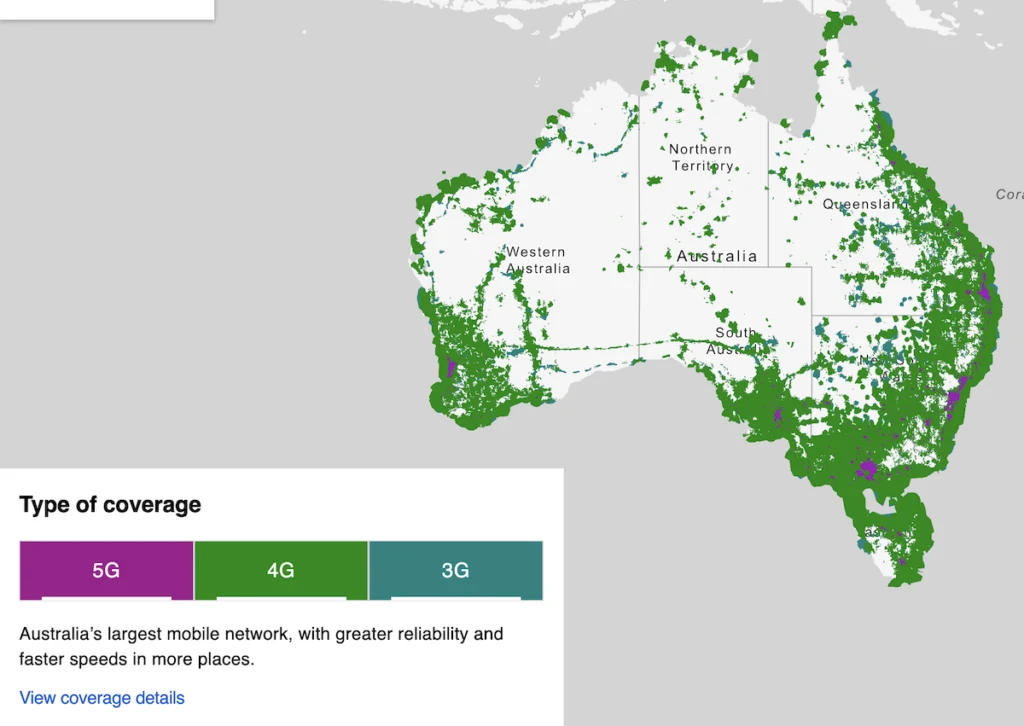
Telstra Coverage Map
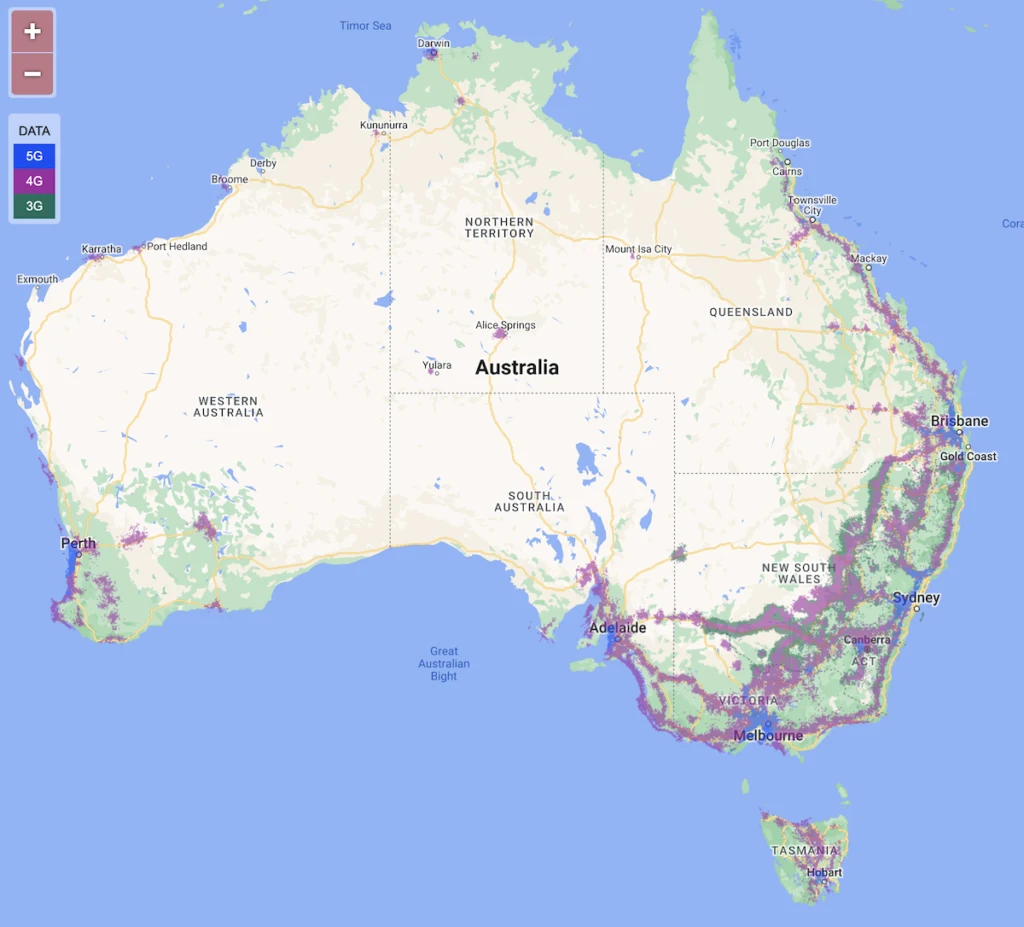
Vodafone Coverage Map

Optus Coverage Map
If you live in Australia already, then you’ve likely got your phone sorted out already.
If you’re travelling to Australia from somewhere else, then you will probably want a prepaid service. Many of the pre-paid phone offerings (and there are lots) will use either the Telstra or Optus network.
Internet
Here’s how you’re going to get internet in Australia:
Free Wi-Fi
Free Wi-Fi can be found in all the regular places: shopping malls, airports, MacDonalds, hotels and libraries. Most often this will be capped, so of course this is only good for checking email, social media and browsing.
Hot Spot from your phone or mobile modem
This is a popular, and easy solution. If you’re with Telstra you’ll be able to get internet most of the time. For those on pre-paid it may be your only option.
Starlink
It’s hard to beat the coverage of satellite internet, and Starlink is surging in popularity.
7. How to plan your route around Australia
So you’ve arrived in Australia, you’ve got your home on wheels, you’ve packed in your clothes and bedding, you’ve stocked up the cupboards and fridge and you’re ready to hit the road!
But which way do you go?
Well, that will depend on a few factors; where you’re flying in and out of, the time of year that you’re visiting, how long you’ve got and your bucket list of must-see places. But the main factor that you’ll want to keep in mind is the weather.
Weather
Because Australia is so large, it has a wide variety of landscapes… and weather. In the north you have tropical rainforests, in the south and east you have mountain ranges and the centre is one huge dry desert.
So you’ll want to consider the timing of your visit to some of these areas.
North
The north of Australia is semi-tropical, making it very hot and humid in the summer (Dec-Feb) and subject to monsoonal type rains and tropical cyclones. The rainy season runs from approximately November to April and can severely hamper travel in the region. Some roads become impassable, being either washed away or totally underwater.
The Middle
The vast expanse that is the middle of Australia is desert or semi-arid. In the summer, temperatures can be in the high 30’s to 40°C (104°F) during the day.
The winter months are a popular time to travel to the centre of Australia because the day time temperatures are comfortably warm, but you do need to be aware that at night the temperature plummets and you’ll want to have warm clothing and bedding.
The South
A more temperate climate is found in the south-east and south-west regions of Australia. While it’s cold for us, it will rarely get as cold as 0°C (32°F) so it’s not nearly as frigid as our northern hemisphere visitors would be used to.
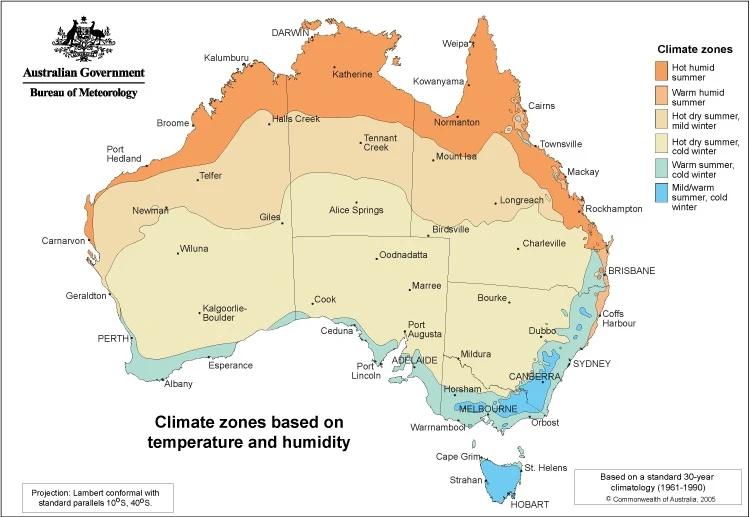
The southern hemisphere seasons are:
- Summer – December, January, February
- Autumn – March, April, May
- Winter – June, July, August
- Spring – September, October, November
You will find that many, if not most, people travelling around Australia will travel to the northern half and centre of the country in winter, and enjoy the warm tropical weather while avoiding the monsoonal rains and heat of summer.
Then in summer, they’ll head back south again where it will still be a hot summer, but not as hot.
Shoulder Season
We found ourselves travelling in the north of the country during the spring shoulder season (August/September) and we loved it. While literally hundreds of caravans were heading south as we went north we got to enjoy much less crowded camps but still pleasant temperatures.
Public Holidays & School Holidays in Australia
Being mindful of the public holidays will most likely help you with ‘crowd-control’ more than anything.
Starting your trip in Sydney? Well you DO NOT want to be picking up your campervan from the airport at 2pm on the Thursday before Easter and be heading north. You will be joined by every Sydney-ite desperate to leave the city limits on their first long weekend since summer.
Sure you could do it, but it will save yourself a heap of stress if you knew it was a long weekend and decided to stay the night near the airport instead.
You can find all the public holidays here and since it would also be best to avoid school holidays, if possible, here’s the link to them here too.
Bucket List items
And then, of course, the other thing to take into consideration is those ‘bucket list’ places that you’ve always wanted to see.
Planning the actual route
Online Trip Planners – these are where you can input your start and finish points, and stops along the way, and it will show you your route along with some tourist attractions along the way. I find them to be a little bit limiting, but they can be a great way to start your planning and give you some ideas.
Here’s one from the NRMA that you may find helpful: Holiday Finder
Pre-made Itineraries – you’ll find lots and lots of itineraries already planned out for you, if you’d like to go that route. For example, Tourism Australia has some great self-drive itineraries here, that you could just follow these trips and you’ll have a great time.
But chances are, you’ll use them as a guide for planning your route, taking note of the things they recommend that appeal to you, and ignoring the rest.
Google Maps – if you enjoy the planning process, you could use something as simple as google maps and enter in your start and finish points, and the places on your bucket list in between.
It’s great how google maps gives you the drive times so you’ll be able to gauge how far you can travel each day.
While you’re there, you can search for local accommodation, restaurants and things to do. You can have a look at the map and see how far away the water is, the next town, the next interesting site to visit.
You can use the information that you find from itinerary examples and online trip planning tools to give you some idea of what would make a good trip, but then totally design it to your own needs, desires, budget and timeframe.
Personally, it’s my favourite way of planning for a trip because I’m in total control.
8. How to pack for a road trip around Australia
Packing is a bit of a personal preference and I’m certainly no fashionista, so I won’t be listing out the clothes I think you’ll need. But rather, some of the items that you may not think about bringing.
So of course, bring the shorts, t-shirts, nice dress, button up shirt, comfy undies and high heels if that’s what you want, these are the other things:
Protection against bugs
Light coloured and loose, long sleeve top and long pants
As dusk approaches and you want to sit outside with your glass of chardonnay or tinnie of VB, there’s a good chance that the mosquitoes or sand flies are also thinking of settling in for their happy hour feast… of you!
It’s no fun wearing longs when it’s so hot, but it’s either that or get eaten alive. Or sit inside.
This is a particularly sore point for me, because the insects seem to LOVE me. Insect repellent and long everything doesn’t seem to deter them. They find their way in and it’s no fun.
Insect Repellent
Everyone says that the only insect repellent that is any good must have DEET in it to be effective. While I’ve been happy enough to buy this at the supermarket I have to admit, it is a pretty ‘corrosive’ product. We had a roll-on insect repellent that leaked and while I can’t remember what it corroded or stripped, but it was dramatic enough that we did quickly decide that it need to be stored in a zip lock bag from now on. And we put this stuff on our skin!?
I’ve read quite a few recommendations for natural products available here in Australia. I’m not endorsing them, because I haven’t tried them; but I’ve heard them mentioned a quite a few times so I’m putting their website links here for your reference: Good Riddance & The Locals
Heat & Sun
Okay okay, everyone sees pictures of sun-kissed Aussies enjoying the beach, splashing around in their next-to-nothings and looking youthful and happy.
That picture is not so common anymore.
More and more people are becoming painfully aware of our harsh Aussie sun and seeking protection from it.
Hat
While a cap may look cool, if you’ve got a favourite wide-brimmed hat then I’d bring that with you. If not, you’ll be buying one when you get here anyway.
Long sleeves and pants
You know, when you see anyone that works out in the Australian sun all day (think road workers, farmers, those crazy cyclists and hikers that walk through the outback) they are most often wearing long pants and sleeves and a wide brim hat. Take your cue from them, especially if you’ll be spending your whole day outside in the summer.
Rashie
In the water is where we are usually having the most fun and so forget to reapply sunscreen. Rashies are so, so popular now, so join the trend. They are especially great for kids, and everyone is wearing them, so you won’t be the odd one out.
Sunscreen
It’s not as effective as staying out of the sun in the first place. But if you can’t/won’t keep your skin out of the sun then at least find a high SPF sunscreen and reapply regularly.
The Cold
Yes, it does get cold!
I’ve reminded you a few times throughout this post that it can get really hot in many parts of Australia, but it’s certainly not hot all the time and in all places!
If you’re going to be in the middle to south of Australia during the winter months, then you’ll need to pack your warm clothes too. Average winter temperatures would get as low as single digits in ° Centigrade (34-48°F).
And don’t be fooled into thinking that the middle of Australia is hot all the time. In the winter, while day time temperatures may be warm, it can get down to zero (°C) overnight and take a couple of hours to warm up again in the morning.
9. Driving around Australia in a camper van
There are a few considerations that you need to be aware of when it comes to driving in Australia. Things that may be quite different to where you come from, so let’s list them out:
International Drivers
In Australia we drive on the left side of the road and the majority of vehicles have the steering wheel on their right side.
You can use your overseas licence in Australia for your entire visit, as long as you remain a visitor. If your licence is not in English you must also carry an English translation or an International Driving Permit (IDP). Information on the IDP can be found here.
Australian Road Rules
Just like you would in any new country, it makes sense to familiarise yourself with the local road rules. Some of the major points:
- Carry your licence any time you’re driving.
- Drive on the left side of the road, and overtake on the right.
- The posted speed limit should be carefully adhered to when driving your campervan in Australia.
- At no time should mobile phones be used while driving a campervan rental in Australia.
Driving at dawn or dusk
What might be quite different for our international visitors is that if you are in a country area, it is recommended that you don’t drive at dawn or dusk times of the day. This is when the wildlife is the most active, and the chances of you hitting a kangaroo, wallaby, wombat or other creature, increases greatly.
Driver Fatigue
In some parts of Australia you can be driving for hundreds and hundreds of kilometres, with little change in the landscape and huge distances to cover. Don’t push it. If you’re tired, there are plenty of designated rest stops, so make the most of them.
GPS and maps
You may think, like us, that phones are so useful now and that getting a GPS is a waste of time and money.
Or you may have figured out already, unlike us, that in the middle of the outback a phone is useless if you don’t have any reception. So at the time when you really need reassurance that you’re heading in the right direction to your intended campsite… you have no idea.
Unless you’re able to use an app that doesn’t require an internet connection but still uses the GPS function.
Otherwise, I’d recommend getting a GPS so you can have your navigation running all the time and there’s no arguments when you want to use the phone to take pictures and videos to post on Instagram!
And don’t forget the good old paper map. You remember them, right? There is nothing quite so old school, yet safe and practical, as having a physical map. You’ll find these in every Information Centre around the country.
Most Useful Apps
There are gazillions of apps that you could be using to plan and navigate your way around Australia. But for us, there were just a handful that I couldn’t do without:
WikiCamps – I mentioned WikiCamps in the camping section and this is, without a doubt, the most used app on my phone. I used it everyday that we needed to find a new camp.
FuelMaps – There were a couple of times that we became a little concerned that our fuel was running low but we weren’t sure how far it was to the next town. Or we were at a town with half a tank of diesel left but diesel was $1.55 per litre. A quick look on the app assured us that the next town was 130 kms in the direction we were going and it was $1.42 per litre. So we kept driving. It helped us to save money and, more importantly, keep the stress and anxiety levels in check! This app is free.
Special Considerations for Outback Travel
Australia is comparable in size to the United States.
But while the population density of the United States is 33 people per km2, the population density of Australia is a measly 3 people per km2.
Once you have a look at the geography of Australia, it all starts to make sense when you see that most of the middle of Australia is largely uninhabited. Sure there are small towns, and even a large town (Alice Springs) but no cities, and lots and lots of space in-between.
So it’s worth remembering that Australia is large and remote.
Water
It’s not only remote and sparsely populated, it’s also desert or semi-arid. Which means you MUST ensure that you have enough drinking water on-board your vehicle so that, should the unforeseen happen, you can at least stay alive.
Heat
It’s also going to be hot. Depending on the time of year that you travel, it’s going to be really hot. Make sure you’ve got appropriate clothing, that your set-up affords you some shade when you stop, and that you have ways to cool down when you need to.
Some of the ideas we had are a 12v fan, a fridge or freezer for cold drinks, and a spray bottle with water that you can squirt on yourself every now and then.
Fuel & Other Spares
Use the FuelMaps app to see where your next fuel stop is. Carry extra fuel if possible.
Make sure your vehicle is in good working order before you leave on your trip.
Make sure to take the common spares such as oil, water, spare wheel & wheel changing kit, some basic tools.
Road Conditions
You should also be aware of any road closures or warnings about roads where you’re intending to travel.
You may have to do some googling, but here are the websites about road warnings for each state:
Road Trains
When driving in the outback you’re likely to come across some road trains. These are huge trucks with 3-4 trailers behind the truck cab, and they can be quite intimidating with their size. This article explains how you should react when you have a road train coming towards you, and the best way to overtake a road train.
Alcohol Restricted Areas
Here’s something you may not be aware of:
There are parts of Australia where alcohol restrictions are in place. You will come across these areas in parts of the Northern Territory, Far North Queensland and some parts of Western Australia. The restrictions vary in each state and area, and are constantly changing, but can be a total ban on alcohol consumption or a limit on how much you can buy, when you can buy and what you can buy.
There will be signs on the road as you enter into these restricted areas, but you’ll also be made well aware of any restrictions when you buy alcohol. If in doubt, just visit the nearest Information Centre and they’ll have all the info you need.
10. How much does it cost to road trip Australia?
Now, this is going to be the hard section to write. Of course you already know that everyone is different so eveyones road trip around Australia budget is going to be wildly different.
If you’re on holiday for a limited time, you may not be so worried about costs because you’re going back to work as soon as you get home anyway; compared to the person who has made being on the road their new lifestyle, and is now a lot more selective about what he spends his limited resources on.
First up, particularly for our international visitors, Australia is expensive.
All cost estimates are in Australian Dollars.
I think the most helpful thing I can do here is to share how we set up our budget.
Setting a budget
Setting a budget for something when you don’t even know what you’re getting yourself into, can be quite hard. But I did lots and lots of research and did the best I could.
Our budget was divided into two parts, the One-Off or Set-Up Costs that we would incur within the first few weeks of arriving in Australia, and then our expected Living Expenses for the time we intended to be on the road (in our case, 6 months).
One-off costs
Here are the one off costs you may need to consider:
- Getting to Australia – Fights, rental car, hotel etc. This will be zero if you live in Australia already, significantly more if you have to come from the other side of the world.
- Campervan Hire or Purchase
- Insurance – both travel insurance and vehicle insurance if you decide to purchase
- Roadside Assistance – through NRMA
- Maintenance – If you purchase a campervan you’ll want to consider regular servicing and maintenance, and a contingency fund.
- Misc – because there’s always miscellaneous!
- Other bills or giving– mortgage, car loans, students loans, charitable giving – anything else that you will keep paying regardless of the fact that you’re heading off on a trip of a lifetime.
Living Costs
When trying to come up with a ‘living budget’ for our road trip around Australia, I racked my brain for all the things I thought we’d need to pay for. I started with the things we already pay for in our lives – rent, food, petrol, phones, internet, entertainment, gifts, subscriptions.
And then added all the things that would be extra being on this trip.
You’re unlikely to get it perfectly right, but figuring out a budget beforehand, allows you to know how long your money is going to last you.
If you’re waaaay overspending your weekly budget you’ll be able to know in advance that you’re likely to run out of money. Either that’s fine… and you break out the credit card. Or you tighten your belt and cut back on the less important things.
So here’s how I determined our monthly budget:
Camping fees – from some quick online research I could see that $30 per night for a caravan park (unpowered site) was reasonably normal. Ben and I talked about trying to free camp for four nights per week and staying in a caravan park for the other three nights per week. That gave us a budget of $90 per week for camping fees, which I rounded up to $400 per month.
Not exactly a science to my methods, but at least it gives us something to work with.
Food – we’ll still eat generally the same things as we do now and in the same quantities, so that shouldn’t change too drastically.
For any international readers, I would suggest taking the time to go through one of your regular weeks grocery list and jumping on to an online shopping site like www.shop.coles.com.au to price each of the items. It’s a time consuming exercise for sure, but it will give you a really good idea of what you should budget for.
Fuel – it’s gonna be a lot, I mean you are driving around Australia. Here’s how I roughly calculated how much fuel would cost us.
| Kms travelled | x | Fuel Consumption per km | x | Price per litre | = | Total Fuel Cost |
Expected KMs – I use google maps to give me an approximate kilometres for the trip I’d like to do.
Fuel Consumption per 100km – I found some figures online as I was doing all the general research for this trip, that showed people reporting fuel consumption of 12-20L per 100km. I saw on drive.com.au that they quoted 14L per 100km, so I just used that.
Price per litre – just ask google what the current average price of diesel per litre is in Australia.
As you can see, it’s not an exact science, but at least it gives you a general idea. Then you’ll know if your fuel budget will be closer to $1,000 or $5,000.
Electricity – will now be zero as it’s covered in the nightly rate at caravan parks, or by your onboard battery system.
Phone / Internet – you can look on the Telstra website and see which pre-paid or contract plan (depending on which suits your circumstances) works for you.
Spending – this one is a bit of a guess but here are some of the costs you should consider in this category:
- Coffee – although I love a good coffee, I would only buy one as a treat, so I don’t need a separate budget for it.
- Alcohol – this on the other hand… we probably should budget for. :-O
- Sightseeing Trips – you’ll need to factor in museum or attraction visits or any of the we’re-only-here-once-so-we’d-better-do-it visits.
You know, things like swimming with whale sharks, a scenic flight over Uluru or a sunset cruise on Sydney Harbour. If there are must-dos on your list, then I would find out the price of each of those attractions (online) and add them to the budget. - Eating out – any takeaways, pub, café and restaurant meals.
- Hair and beauty – haircuts and styling, nails, waxing – anything that you know you’ll want to get done while you’re on the trip.
- Dog sitting services – if you’ve got an extra family member with you
- Kid expenses – I don’t know what extra costs kids have, but I hear they’re expensive. ☺
11. How to fund your road trip around Australia
This is the question that has always stumped me the most.
I had always thought it would be at least $100k for a motorhome and then $50k to travel for a year. While that is a HUGE amount of money and already felt out of our reach, the idea of then having to go back to work, well, I think that might have been the most frightening prospect of all.
So a few things had to happen before we could even contemplate setting out on our own trip.
- We had to downsize our motorhome expectations A LOT, and
- We had to either figure out ways of making money online, or get comfortable with needing to stop and work as needed.
Downsizing our motorhome expectations
I thought that travelling around Australia would only happen when I had a big motorhome. But as I saw more and more people sharing their journeys as they travelled around the USA and Australia, I released that I didn’t need a big, fancy rig… I just needed to go.
So I started looking for something more in our price range. For us, it was a car and camper trailer. In hindsight, I think we would have been just as happy in a car with a roof top tent, or a van with just a mattress in the back.
Once we downsized our expectations, we realised we could embark on a trip now, rather than waiting for retirement.
And then we had to figure out how we were going to fund our travels (other than our savings).
Blogging
We have 5 websites (in the camping, caravanning, campervan niche) and we make money through advertising, affiliate marketing and selling digital products.
Blogging is a long game and it took us years to make more than just a couple of hundred dollars per month.
So in the short term, the two other ways we would make money online is through offering virtual assistant services and freelancing.
Virtual Assistant
In a nutshell; a virtual assistant is someone who helps you run your business, whether a traditional or online business, by doing any online tasks that you need.
This could be ANY tasks that can be completed online.
It could be admin tasks anyone in the corporate may undertake like: diary management, minute taking, email management, answering the phone, ordering stock, managing a database, customer service or cold calling.
Or it may be scheduling posts on your blog, social media management, email marketing or running ads.
I used to be a VA for 2 other bloggers, who found me via my own blogs, liked my writing style and asked if I needed work. They were both great clients to work for and I could work from anywhere as long as I had phone coverage (for internet).
I think that being a virtual assistant is a fantastic way of creating an online income. It what I’ve done and this is how I got started as a VA.
Freelancing
Generally this is someone who has a specialist skill that they provide to businesses on either a one-off project or an ongoing basis. This includes services like: writing, website development, design, app development and more.
Remote work
Since the pandemic businesses have really embraced the ‘work from home’ idea and if you’re already that type of position, you could transition to taking your job on the road. I mean, you’re still, technically, working from home!
Casual & temping work
This is really popular. You can work in pubs, caravan parks, farms, hotels, construction, hospitals, admin … anywhere, doing anything.
Personally, we signed up with an employment agency whenever we stopped to work, and we had work within a few weeks.
All Around Oz have an excellent article with some great suggestions for how you can find work while travelling around Australia.
I hope this helps you to plan a little bit better, for your campervan Australia road trip. There’s so much to love about hitting the road and seeing so much of what this amazing country has to offer.
Article first appeared on BenAndMichelle.com – used with permission. I mean, that’s me. I’m Michelle.
Don’t forget to sign up for our newsletter, and receive the Campervan Comparison Spreadsheet for free!

